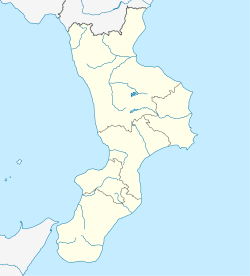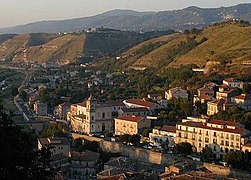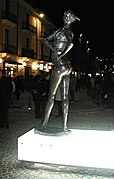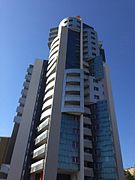Cosenza
Cosenza
Cusenza (Calabrian) | |
|---|---|
| Città di Cosenza | |
 View of the modern city | |
 Cosenza within the province of Cosenza | |
| Coordinates: 39°18′N 16°15′E / 39.300°N 16.250°E | |
| Country | Italy |
| Region | Calabria |
| Province | Cosenza (CS) |
| Frazioni | Donnici, Sant'Ippolito, Borgo Partenope, Muoio |
| Government | |
| • Mayor | Franz Caruso (Italian Socialist Party) |
| Area | |
• Total | 37 km2 (14 sq mi) |
| Elevation | 238 m (781 ft) |
| Population (28 December 2020)[2] | |
• Total | 67,563 |
| • Density | 1,800/km2 (4,700/sq mi) |
| Demonym | Cosentians (Italian: cosentini) |
| Time zone | UTC+1 (CET) |
| • Summer (DST) | UTC+2 (CEST) |
| Postal code | 87100 |
| Dialing code | 0984 |
| Patron saint | Our Lady of the Pillar |
| Saint day | 12 February |
| Website | Official website |
Cosenza (Italian: [koˈzɛntsa] ⓘ; Cosentian: Cusenza, [kuˈsɛndza]) is a city located in Calabria, Italy. The city centre has a population of approximately 70,000, while the urban area counts more than 200,000 inhabitants.[3] It is the capital of the province of Cosenza, which has a population of more than 700,000.
The ancient town is the seat of the Cosentian Academy, one of the oldest academies of philosophical and literary studies in Italy and Europe. To this day, Cosenza remains a cultural hub, with several museums, monuments, theatres and libraries. The modern city is the centre of an urban agglomeration including, among others, the municipality of Rende, where the University of Calabria is located.
Geography
[edit]

Situated at the confluence of two historical rivers, the Busento and the Crati, Cosenza stands 238 m above sea level in a valley between the Sila and the coastal range of mountains. The old town, overshadowed by its Swabian castle, descends to the river Crati. The modern city lies to the north, beyond the Busento, on level ground.
Almost completely surrounded by mountains, Cosenza is subject to a microclimate scarcely influenced by the effects of the Mediterranean Sea. It experiences cold winters and hot summers.
History
[edit]Origins
[edit]The ancient Consentia (Ancient Greek: Κωσεντία),[4] capital of the Italic tribe of the Brettii, was a bulwark of the Italic people against the Hellenic influences of the Ionian colonies. It was in this province that the Battle of Pandosia was fought, in which a small Italic army composed of Brettii and Lucanians defeated the uncle of Alexander the Great, who was known as Alexander of Epirus. Over the centuries, Cosenza maintained a distinctive character, that marked it out among the cities of the region. Under Emperor Augustus, it became an important stopover on the Roman route via Popilia, which connected Calabria to Sicily. During the Roman Empire, the town benefited from municipal privileges.
Alaric's legendary tomb
[edit]
In 410 AD, Alaric I, king of the Visigoths, sacked the city of Rome, becoming the first foreign enemy to capture the city in more than 800 years. Alaric amassed a great amount of treasure during his conquest of Rome. According to the historian Jordanes,[5] after sacking Rome Alaric headed south with his troops, advancing easily until reaching the area of Cosenza, where he died. No one is certain how this happened: Some believe he contracted a disease that took his life, while others feel that his death came from an attack by enemy forces. In any case, his troops honored their king by burying him in a tomb in Cosenza. His burial place is said to have been at the confluence of the Busento and Crathis rivers. A horde of slaves were used to divert the water from the Busento, allowing them to dig a tomb large enough for Alaric, his horse, and all of the treasure amassed from his conquests in Rome. Once the tomb was completed, the river was returned to its bed and the tomb covered with water. Then, to ensure that no one would reveal this location to anyone, Alaric's troops killed all of the slaves.
In the centuries after the fall of the Western Roman Empire, several towns in the province of Cosenza, most notably Rossano, refused to acknowledge the new governments of the Ostrogoths. Instead, they used their good fortune of having strong city walls and small Roman garrisons to hold out for centuries as semi-independent enclaves of the still extant Eastern Roman Empire in Italy.
Norman, Hohenstaufen, and Angevin period
[edit]Bitterly disputed between the Saracens and the Lombards, the town was destroyed, then rebuilt around 988; only to be ravaged again in the early eleventh century. In the attempt to escape the devastation, the population left the town and sheltered on the surrounding hills where they built some small hamlets (still denominated as, casali).
By the first half of the eleventh century, Lombard Calabria became a feudal dukedom of the Normans, with Cosenza as the capital. The town soon rebelled against the rule of Roger Guiscard and was recaptured only after a long siege. Subsequently, under the Hohenstaufen rule, the town became the seat of the Court of Calabria (Curia Generale). Emperor Frederick II had a particular interest in the town: he promoted construction and economic activities, organising an important annual fair.
Subsequently, Cosenza fought bitterly against the Angevin domination, supported by the clergy. While the uprising spread through the valley of the Crathis, the town was involved in the see-sawing fight between Angevins and the Crown of Aragon. In 1432, King Louis III of Anjou settled in the castle of Cosenza with his wife Margaret of Savoy. When he died untimely, in 1434, he was buried in the cathedral.

Spanish domination
[edit]In 1500, in spite of resistance, Cosenza was occupied by the Spanish army led by Captain Gonzalo Fernández de Córdoba. During the sixteenth century the town experienced a period of expansion as the seat of the Viceroy of Calabria. At the same time its cultural importance grew thanks to the foundation of the Accademia Cosentina; among its most renowned members were Bernardino Telesio, Aulo Gianni Parrasio, the Martirano brothers, Antonio Serra, and others.
In 1707, the Austrians succeeded the Spanish in the Kingdom of Naples, followed by the Bourbons. After the proclamation in 1799 of the short-lived Parthenopean Republic and a vain resistance, the town was finally occupied for the Bourbons by Cardinal Fabrizio Ruffo's Lazzari. Cardinal Ruffo was native of the province of Cosenza.
Modern age
[edit]From 1806 to 1815, Cosentians fought hard against French domination. Cruel suppressions characterised that period and it was a cradle of the Carbonari secret societies. In 1813, the town saw many rebels executed. The local riots of 1821 and 1837 heralded the Risorgimento. They were followed by the uprising of 15 March 1844, which reached its climax with the “noble folly” of the Bandiera Brothers, who were executed together with some of their followers in the Vallone di Rovito in Cosenza. In 1860, some months after the rapid and overwhelmingly heroic deeds of Garibaldi's troops, a plebiscite proclaimed the annexation of Calabria to the new Kingdom of Italy.
Government
[edit]Population
[edit]
|
| ||||||||||||||||||||||||||||||||||||||||||||||||||||||
| Source: ISTAT | |||||||||||||||||||||||||||||||||||||||||||||||||||||||
Between 1951 and 1971, Cosenza saw its population nearly double from 57,000 to 102,000 people, the years of abandonment of the city's historic center in favor of urban suburbs, often lacking services. Since 1981, when the population peaked at nearly 107,000 people, the city has lost approximately 40% of its then-population, largest of any Italian provincial capital and of any city larger than 10,000 people, mainly towards the surrounding municipalities, like Rende, Castrolibero, Mendicino, Montalto Uffugo and Marano Principato. This is typical of many Italian provincial capitals, where the urban area over time evolved from a city enclosed within municipal boundaries to a metropolitan area, thanks to the gradual incorporation of the municipalities surrounding the city, which since the 1980s have gone on to form a complex urban fabric with it.
Climate
[edit]| Climate data for Cosenza (1981–2010) | |||||||||||||
|---|---|---|---|---|---|---|---|---|---|---|---|---|---|
| Month | Jan | Feb | Mar | Apr | May | Jun | Jul | Aug | Sep | Oct | Nov | Dec | Year |
| Mean daily maximum °C (°F) | 12.3 (54.1) |
13.0 (55.4) |
16.0 (60.8) |
19.1 (66.4) |
24.5 (76.1) |
29.2 (84.6) |
32.2 (90.0) |
32.7 (90.9) |
27.7 (81.9) |
22.9 (73.2) |
17.3 (63.1) |
13.1 (55.6) |
21.7 (71.0) |
| Daily mean °C (°F) | 8.3 (46.9) |
8.5 (47.3) |
10.9 (51.6) |
13.7 (56.7) |
18.4 (65.1) |
22.7 (72.9) |
25.4 (77.7) |
25.9 (78.6) |
21.5 (70.7) |
17.4 (63.3) |
12.6 (54.7) |
9.2 (48.6) |
16.2 (61.2) |
| Mean daily minimum °C (°F) | 4.2 (39.6) |
3.9 (39.0) |
5.9 (42.6) |
8.4 (47.1) |
12.3 (54.1) |
16.2 (61.2) |
18.6 (65.5) |
19.0 (66.2) |
15.4 (59.7) |
12.2 (54.0) |
7.9 (46.2) |
5.2 (41.4) |
10.8 (51.4) |
| Average precipitation mm (inches) | 121 (4.8) |
105 (4.1) |
90 (3.5) |
67 (2.6) |
46 (1.8) |
28 (1.1) |
15 (0.6) |
24 (0.9) |
64 (2.5) |
86 (3.4) |
132 (5.2) |
133 (5.2) |
911 (35.7) |
| Average precipitation days (≥ 1.0 mm) | 10 | 10 | 8 | 9 | 6 | 4 | 3 | 3 | 7 | 8 | 11 | 12 | 91 |
| Source 1: Istituto Superiore per la Protezione e la Ricerca Ambientale[6] | |||||||||||||
| Source 2: Climi e viaggi (precipitation days)[7] | |||||||||||||
Main sights
[edit]Church of San Domenico
[edit]


Founded in 1448, the Church of San Domenico combines Medieval and Renaissance architectural elements. Its most interesting feature is the rose window defined by 16 little tuff columns. The wooden portal (1614) is inlaid with floral motifs, figures of saints, and coats of arms.
Inside the church are works by the sanfilese painter Antonio Granata, such as the canvas depicting the Madonna of the Rosary between Saints Dominic and Agnese da Montepulciano preserved in the ancient choir used today as a sacristy in the church (late eighteenth century). The high altar is made of polychrome marble (1767). In the transept, there is a Deposition and a San Vincenzo Ferreri (late eighteenth century, anonymous). The sacristy is noted for its ribbed vault, a double lancet window with a narrow arch, and a wooden choir installed in 1635.
The Cathedral
[edit]The exact origins of the Duomo (Cathedral of Santa Maria Assunta) are unknown; it was probably built during the first half of the eleventh century. An earthquake destroyed the cathedral on 9 June 1184, and rebuilding was completed by 1222, when the cathedral was consecrated by Emperor Frederick II. At some point during the first half of the eighteenth century the church was covered by a baroque superstructure that obliterated the original structure and its works of art. In the first half of the nineteenth century the façade was transformed in neo-gothic style, which completely changed its character. At the end of the nineteenth century, Archbishop Camillo Sorgente entrusted restoration work to Pisanti, who recovered the original old arches and the ancient structure of the church. In the 1940s the work was finally completed.
The tomb of Isabella of Aragon, wife of king Philip III of France is in the transept. A long aisle links the Duomo to the palace of the archbishop, the Palazzo Arcivescovile, which houses an Immacolata by Luca Giordano. One can also see a rare and precious Stauroteca. A Stauroteca is a relic containing fragments of wood from the cross of Christ. It generally has a rectangular and flat rectangular cross or rectangular tee with cruciform recipe used to guard the relic. It was a gift from Emperor Frederick II to the Duomo upon consecration. The work was produced in workshops of the royal goldsmiths, better known as "Tiraz", in a cultural environment blending Arabic, Byzantine, and Western cultural elements.
Monastero delle Vergini
[edit]The "Convent of the Virgins" stands in via Gaetano Argento. The external part of the main entrance is made of decorated tuff, while the internal part is carved of wood. The convent contains a sixteenth-century painting of the Annunciation. In front of it, is the thirteenth-century Madonna del Pilerio attributed to Giovanni da Taranto, while on the walls are four other anonymous sixteenth-century paintings: the Visitation, the Circumcision, the Adoration of the Shepherds, and the Adoration of the Magi. In the apse is the altarpiece Transit of the Virgin (1570). The cymatium houses a painting portraying the Coronation of the Virgin, while at the base of the two columns are paintings of two unidentified saints that are attributed to Michele Curia, the "Master of Montecalvario". The wooden choir dates to the seventeenth century.
Giostra Vecchia
[edit]In the fifteenth century, at Palazzo Falvo the Renaissance was introduced at Cosenza, in the Giostra Vecchia. Here are located the church and monastery of Saint Francis of Assisi. The Latin cross plan has a nave and two aisles. In the nave stands the impressive high wooden altar built in 1700. Above it is a painting by Daniele Russo representing the Perdono d’Assisi (1618). The left aisle is home to a wooden seventeenth-century crucifix, the altar of the Madonna della Febbre and the statue of the Madonna with Child, in marble, dating to the sixteenth century. The sacristy has a painted wooden ceiling, a wooden armadio representing episodes from the Passion of Christ, and paintings of saints and Franciscan friars. The stone arch is characterized by the painting of St. Francis of Paola, while on the walls are some frescoes dating to the beginning of the fifteenth century.
Hohenstaufen Castle
[edit]




The Castello Svevo ("Swabian" or Hohenstaufen Castle) was originally built by the Saracens on the ruins of the ancient Rocca Brutia, around the year 1000. The castle was restored by Frederick II, Holy Roman Emperor, adding the octagonal tower to the original structure, in 1239. According to tradition, his son Henry lived in this castle, as a prisoner at his father's command. Louis III of Naples and Margaret of Savoy married in the castle and they both settled there in 1432.
All signs of the ancient Saracen structure have now disappeared. In the internal cloister, the modifications made by the Bourbons in order to convert it into a prison can also be seen. The entrance-hall is covered by ogival arches with engraved brackets. A wide corridor is dominated by some fleur-de-lis from the House of Anjou coat of arms. They are engraved on the ribbed Hohenstaufen arches.
Spirito Santo
[edit]The church of Sant'Agostino, also known as the Spirito Santo, was built in 1507 by the Augustinians. The original portal has several inscriptions in Gothic characters. The interior has a series of paintings from the eighteenth century. Further on a narrow street leads to the so-called “Area of the Bandiera Brothers”, the Vallone di Rovito. Here, the insurrectionist patriots of 1844 were executed by a firing squad.
San Francesco di Paola
[edit]In the Arenella, are the church and monastery of Saint Francis of Paola (1510). The interior, with a single nave, houses the tomb of Ottavio Cesare Gaeta. On the right wall, are two eighteenth-century paintings: a Sacra Famiglia and Madonna con San Francesco e Sant’Agostino. On an altar is a wooden statue of Saint Francis of Paola; while on the left side of the nave, on another altar, is a wooden statue of San Michele Arcangelo. The Madonna with Child in Glory and Saints Paul and Luke (1551) was painted by Pietro Negroni. In the apse, a sixteenth-century triptych made by Cristoforo Faffeo represents the Madonna and Child in glory with saints Catherine and Sebastian. At the back of the altar is a wooden choir built in 1679 by M. Domenico Costanzo da Rogliano. On the wall of the sacristy are remains of frescoes dating back to 1550–1600. On the vault are some pastels representing scenes from the life of the Saint from Paola.
San Salvatore
[edit]The small church of San Salvatore serves the parish that professes the Byzantine-Albanian faith. Inside the nave are a wooden ceiling, some frescoes of the Apostoli, of the Salvatore, and of the Madonna, as well as a splendid iconostasis.
Open Air Museum
[edit]In the modern part of Cosenza, in an area stretching from the pedestrianized Corso Mazzini to Piazza Bilotti, lies the open-air "Museo MAB" (Museo all'aperto Bilotti). The museum hosts a wide range of modern art sculptures that stand in the street for residents and tourists. The sculptures were donated to the city by the Italian-American entrepreneur and art collector, Carlo Bilotti. They include Saint George and the Dragon by Salvador Dalí, Hector and Andromache by Giorgio de Chirico, "the Bronzes" by Sacha Sosno, The Bather by Emilio Greco, The Cardinal by Giacomo Manzù, and various marble sculptures by Pietro Consagra.
Museums and cultural institutions
[edit]- National Gallery - Palazzo Arnone
- Civic Archeological Museum
- Remembrance Museum
- Bilotti Open Air Museum
- Rendano Theatre
- Morelli Theatre
- Acquario Theatre
- Cosentian Academy
- University of Calabria
- Music Conservatoire
- State Archive Library
- Civic Library
- National Library
- District Library
- Children's Library
- Antonio Guarasci Foundation Library
- Calabria Jazz Centre Recordings Archive
- Theological Library (Seminario Cosentino)
- Cultural and Ethno-Anthropological Heritage Archive
Sports
[edit]Cosenza is home to Serie B football team Cosenza Calcio.
Events and festivals
[edit]- Fiera di S.Giuseppe - March
- Festival delle Invasioni - July
- Festa del Cioccolato (Chocolate Festival) - October
- La sagra dell'uva e del vino (Wine Festival) in Donnici - October
Notable people
[edit]- Joachim of Fiore (c.1135-1202), theologian born in Celico
- Aulo Giano Parrasio (1470–1521), humanist
- Bernardino Telesio (1509–1588), philosopher
- Pietro Negroni (1505–1565), painter
- Antonio Serra (late 1500s), economist
- Sertorio Quattromani (1541–1607), philosopher
- Niccolò Pasquali (1717/18–1757), musician
- Francis Pasquali (fl.1743–1795), musician
- Francesco Saverio Salfi (1759–1832), writer
- Giovanni Antonio Palazzo (17th-century), writer
- Nicola Misasi (1850–1923), writer
- Alfonso Rendano (1853–1931), pianist
- Alessandro Longo (1864–1945), composer born in Amantea
- Pietro Mancini (1876–1968), politician born in Malito
- Fausto Gullo (1887–1974), politician born in Catanzaro
- Giacomo Mancini (1916-2002), politician
- Stefano Rodotà (1933-2017), politician
- Tony Parisi (1941-2000), wrestler
- Sandra Savaglio (born 1967), astrophysicist
- Mark Iuliano (born 1973), former football player, football manager
- Maria Perrotta (born 1974), pianist
- Stefano Fiore (born 1975), former football player
- Simone Perrotta (born 1977), former football player born in England
- Gennaro Gattuso (born 1978), former football player, football manager born in Corigliano Calabro
- Brunori Sas (born 1977), singer
- Maria Perrusi (born 1991), model
- Domenico Berardi (born 1994), football player born in Cariati
- Giovanni Tocci (born 1994), diver
- Antonio Fuoco (born 1996), racing driver born in Cariati
International relations
[edit]Twin towns – sister cities
[edit]Cosenza is twinned with:
 Kenosha, Wisconsin, United States, since 1979[8]
Kenosha, Wisconsin, United States, since 1979[8] Lansing, Michigan, United States, since 2000[9]
Lansing, Michigan, United States, since 2000[9] Sault Ste. Marie, Ontario, Canada, since 2010[10]
Sault Ste. Marie, Ontario, Canada, since 2010[10]
Gallery
[edit]-
St Francis Bridge
-
Night View
-
The River Crati
-
Villa Rendano
-
The old town
-
The old town in the snow
-
Surrounding Hills
-
View from the riverbank
-
Piazza Campanella
-
Glimpse of the old town
-
Altar to the Bandiera Brothers
-
St. Augustine Monument
-
Open Air Museum
-
Interior of the BoCs Art Museum
-
Open Air Museum
-
Box Art in the old town
-
The Rendano Theatre
-
Interior of the Rendano Theatre
-
Planetary
-
Skyscraper
-
June Fountain
-
Statue in the Old Gardens
-
The River Busento
References
[edit]- ^ "Superficie di Comuni Province e Regioni italiane al 9 ottobre 2011". Italian National Institute of Statistics. Retrieved 16 March 2019.
- ^ "Popolazione Residente al 1° Gennaio 2018". Italian National Institute of Statistics. Retrieved 16 March 2019.
- ^ taken from "Annuario statistico italiano 2008" ISBN 978-88-458-1595-9
- ^ Strabo, Geography, §6.1.5
- ^ Jordanes, De origine actibusque Getarum (551), taken up by Edward Gibbon, Decline and Fall of the Roman Empire, chapter 31.
- ^ "Valori climatici normali di temperatura e precipitazione in Italia" (PDF). Istituto Superiore per la Protezione e la Ricerca Ambientale. Retrieved 26 November 2024.
- ^ "Clima - Cosenza (Calabria)". Climi e viaggi. Retrieved 26 November 2024.
- ^ "Sister Cities - City of Kenosha". www.kenosha.org. Retrieved 2 April 2018.
- ^ "Living Here | Sister Cities | City of Lansing, Michigan". Lansingmi.gov. Archived from the original on 2012-10-28. Retrieved 2013-03-26.
- ^ "Archived copy" (PDF). Archived from the original (PDF) on 2011-10-03. Retrieved 2010-08-11.
{{cite web}}: CS1 maint: archived copy as title (link)
External links
[edit]- (in Italian) Cosenza official website
 This article incorporates text from a publication now in the public domain: Herbermann, Charles, ed. (1913). "Cosenza". Catholic Encyclopedia. New York: Robert Appleton Company.
This article incorporates text from a publication now in the public domain: Herbermann, Charles, ed. (1913). "Cosenza". Catholic Encyclopedia. New York: Robert Appleton Company.



























